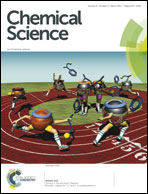Macrocyclic shape-persistency of cyclo[6]aramide results in enhanced multipoint recognition for the highly efficient template-directed synthesis of rotaxanes†
Abstract
Examples of using two-dimensional shape-persistent macrocycles, i.e. those having noncollapsible and geometrically well-defined skeletons, for constructing mechanically interlocked molecules are scarce, which contrasts the many applications of these macrocycles in molecular recognition and functional self-assembly. Herein, we report the crucial role played by macrocyclic shape-persistency in enhancing multipoint recognition for the highly efficient template-directed synthesis of rotaxanes. Cyclo[6]aramides, with a near-planar conformation, are found to act as powerful hosts that bind bipyridinium salts with high affinities. This unique recognition module, composed of two macrocyclic molecules with one bipyridinium ion thread through the cavity, is observed both in the solid state and in solution, with unusually high binding constants ranging from ∼1013 M−2 to ∼1015 M−2 in acetone. The high efficacy of this recognition motif is embodied by the formation of compact [3]rotaxanes in excellent yields based on either a “click-capping” (91%) or “facile one-pot” (85%) approach, underscoring the great advantage of using H-bonded aromatic amide macrocycles for the highly efficient template-directed synthesis of mechanically interlocked structures. Furthermore, three cyclo[6]aramides bearing different peripheral chains 1–3 demonstrate high specificity in the synthesis of a [3]rotaxane from 1 and 2, and a [2]rotaxane from 3via a “facile one-pot” approach, in each case as the only isolated product. Analysis of the crystal structure of the [3]rotaxane reveals a highly compact binding mode that would be difficult to access using other macrocycles with a flexible backbone. Leveraging this unique recognition motif, resulting from the shape-persistency of these oligoamide macrocycles, in the template-directed synthesis of compact rotaxanes may open up new opportunities for the development of higher order interlocked molecules and artificial molecular machines.
![Graphical abstract: Macrocyclic shape-persistency of cyclo[6]aramide results in enhanced multipoint recognition for the highly efficient template-directed synthesis of rotaxanes](/en/Image/Get?imageInfo.ImageType=GA&imageInfo.ImageIdentifier.ManuscriptID=C6SC04714A&imageInfo.ImageIdentifier.Year=2017)


 Please wait while we load your content...
Please wait while we load your content...